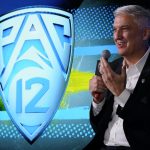The ACC’s proposed payments for Cal and Stanford don’t seem that much higher than what they’d earn in the Mountain West or American. And travel would be worse. So why are Cal and Stanford pushing for the ACC? — @ebrohinho
Because they are desperate to remain in a power conference — so desperate that they have offered major concessions to appease the four ACC schools in opposition to expansion.
Essentially, the Cardinal and Bears are on hands and knees, shamelessly begging for an escape hatch from an awful situation that they themselves created.
The subpar states of their football and men’s basketball teams in recent years left the Bay Area schools without offers from the Big Ten during either of its western raids (the L.A. schools in 2022 and the Northwest schools in 2023).
Now here they are, with the ACC as the lone lifeline to power conference status, the only option for linking arms with the major college elite.
So deep is the desperation that Cal and Stanford are willing to join a conference based in Charlotte and schlep their Olympic sports back and forth across the country …
That they are willing to accept reduced revenue shares from the ACC …
And willing to lock in their media rights with the ACC until 2036, an eternity in college athletics …
The financial piece must be hammered out in negotiations, but we have a working framework to assess.
The Cardinal and Bears would receive reduced revenue shares (compared to the existing ACC members) on a laddered basis.
In the early years of their membership, the Bay Area schools would receive quarter-shares (approximately), with the amount increasing until 2036. According to a source, the average over time would be roughly 50 percent.
That would place each school about $15 million behind, with the gap steadily disappearing.
Yes, the annual media revenue in the initial ACC years would be comparable to what the two schools would receive if they rebuilt the Pac-12.
Stanford, which has more money than it could possibly spend, will offset the lower revenue internally.
Cal doesn’t have the institutional wherewithal to cover the revenue disparity, but it does have UCLA.
Last year, the University of California Regents attached a condition to UCLA’s move to the Big Ten: The so-called Berkeley tax would force the Bruins to subsidize Cal between $2 million and $10 million annually for the drop in Pac-12 revenue caused by UCLA’s departure.
We suspect the subsequent collapse of the Pac-12, combined with Cal’s plight, will move the regents to impose a subsidy on the high side of that range. So the Bears could offset reduced revenue in the ACC through the fee imposed on UCLA.
(The Bruins are expected to receive an average of approximately $65 million per year from the Big Ten’s media rights deal. Remove $10 million for the Berkeley tax and another $8 million to $10 million from increased travel costs, and UCLA’s net annual revenue, excluding postseason events, from the Big Ten could fall into the mid-$40 million range.)
Put another way: The Bay Area schools have financial mechanisms in place to remain competitive despite the reduced shares required for membership in the ACC.
The more consequential issues are locking in their media rights until 2036 and sending their Olympic sports back and forth across the country.
For years, the schools refused to fully engage in the necessary evils of college sports that would have helped their football and basketball programs compete.
Why? Because those evils ran counter to the academic missions and institutional cultures on each side of San Francisco Bay.
Yet here they are, desperate for membership in a conference on the Atlantic Seaboard, prepared to send their athletes back and forth across the country and prime examples of the very evils they purportedly stood against.
Years of poor decisions have left them with no choice.
Could the ACC make a bigger power move and take Oregon State, Washington State, and San Diego State, also at reduced values? This would give ESPN more western inventory for programming and reduce travel for all schools by helping with scheduling logistics for all sports. —@NJ4Liberty
Anything is possible, but that scenario pushes reality to its breaking point.
Those schools don’t clear the ACC’s academic bar, nor do they have elite Olympic sports programs. And they certainly don’t provide access to the Bay Area media market and Silicon Valley riches.
Meanwhile, ESPN would have plenty of inventory available with Stanford and Cal in the ACC and Utah, BYU, Colorado and the Arizona schools in the Big 12.
More because of geography and resources than competitive success and fan passion, the Cougars and Beavers simply don’t fit anywhere else in the Power Five — err, Power Four.
All the noise is about football, plus generalities about other sports. Stanford women’s basketball coach Tara VanDerveer hasn’t said squat, as far as I know. What about basketball (men & women), volleyball & baseball? — Jeff Richardson
Other than a comment or two by football coach Troy Taylor, no Stanford executives, administrators or coaches have uttered a public peep about the situation (as best we can tell). Nor have they done anything behind the scenes to push their narrative through the national media megaphone.
It’s their choice. And just as the Pac-12 chose radio silence for all those months as rumor and speculation eroded trust and patience, it’s a colossal PR mistake.
Do Pac-12 women athletes have any legal recourse regarding their unexpected move to other conferences? — Dave Hayashida
Yes, they do. It’s called Title IX, and it’s the very reason why USC, UCLA, Oregon and Washington are participating in the Big Ten in all sports.
Otherwise, they would be vulnerable to accusations of unequal treatment of athletes in the Olympic programs.
Title IX is one reason the schools are in this position: By treating football, with its massive scholarship numbers and operational expenses, the same as golf and swimming, Title IX distorted the financial models used by athletic departments and created a system in which they must forever chase the media dollars.
But because of Title IX, that chase must account for the Olympic sports, thus preventing them from getting left behind.
There is much more nuance to the Title IX issue, but that is our broad view of the issues against the backdrop of realignment.
If any of the teams leaving the Pac-12 changed their minds and decided not to leave for another conference, is there a penalty or buyout at this juncture? — Dave Hefner
What are the exit fees for the teams that are leaving the Pac-12? We’ve heard of San Diego State and their $34 million exit fee. Surely, there must be something for the Pac-12. — Tom Zupan
I cannot claim to know the legalese buried in the membership agreements signed by the schools entering the Big Ten and Big 12.
But what reason would any of the Exiting Eight have to reverse course over the duration of their next contract cycles? (For the Big Ten, the media deal expires in 2030; for the Big 12, the term ends in 2031.)
By then, the landscape could look very different. Would it be different enough to force another reshuffling?
That’s a topic for another mailbag … or a book.
Also, there are no exit fees attached to the Pac-12 schools departing next summer. The contracts with ESPN and Fox expire, so they would not break the grant-of-rights agreement; nor do the conference bylaws include an evergreen exit fee.
But for Washington State and Oregon State — and perhaps Cal and Stanford — the situation isn’t as simple as leaping into the Mountain West.
If the schools remain members of the legal entity known as the Pac-12, they could have access to tens of millions of dollars in assets.
Can you comment on the Pac-12 bowl arrangements, contracts (rumored to be intact for another three years) and how that factors in the calculus on the value the Beavers and Cougars have as the last two standing? — @ttowncoug
The Pac-12 began a six-year contract cycle with its bowl partners in the fall of 2020, meaning it runs through the 2025 season — or what would be the first two years of a reconstituted Pac-12.
However, we don’t know the force majeure piece: Do the contracts allow the bowls to sever ties in the event of a monumental unexpected event? (We saw force majeure at work during the pandemic.)
And would the departure of eight schools qualify as a legal justification for dissolving the contracts if Stanford, Cal, WSU and OSU set about rebuilding the conference?
That’s one of many issues that attorneys and financial officers are examining, both inside the conference and on the campuses of the four remaining schools.
Conference realignment may be OK for football, but it’s insane for the other sports. What’s your over/under timeline for football-only conferences nationwide? I’d love to go back to 2010 for conferencing non-football sports. — @262Bear
A football-only structure, if it happens, won’t unfold before the Big Ten’s next contract cycle (starting in 2030) and probably not until the SEC’s next cycle (2034).
But the second half of the 2030s could very well feature something that looks more like the NFL than college football as we’ve known it for 100 years.
Do you think things might be different if the Pac-12 had hired Oliver Luck instead of George Kliavkoff? — @WHS1969
If by “different” you mean better, well, sure: It could not possibly be worse, right?
In many ways, Luck would have been the anti-Kliavkoff, someone steeped in the complexities of college sports, with contacts throughout the industry and zero learning curve required.
We spent five months writing about the need for the presidents to hire someone who understood college football at the deepest level … like Oliver Luck.
Instead, they hired an outsider.
*** Send suggestions, comments and tips (confidentiality guaranteed) to pac12hotline@bayareanewsgroup.com or call 408-920-5716
*** Follow me on Twitter: @WilnerHotline
*** Pac-12 Hotline is not endorsed or sponsored by the Pac-12 Conference, and the views expressed herein do not necessarily reflect the views of the Conference.
Related posts:

(AP Photo/Ralph Freso, File)
Wilner Hotline – One Month Until Football Signing Day, Pac-12 is Struggling
(AP Photo/Marcio Jose Sanchez)
Wilner Hotline – Pac-12 Commish on Lincoln Riley Hire “Can do Nothing But Only Help the Conference”
(AP Photo/Ralph Freso, File)
Wilner Hotline – Pac-12 Football Signing Day Preview
(AP Photo/Rick Scuteri)
Wilner Hotline – Pac-12 Hoops Controversy: Why UCLA won’t Play Arizona. Allow us to explain …
